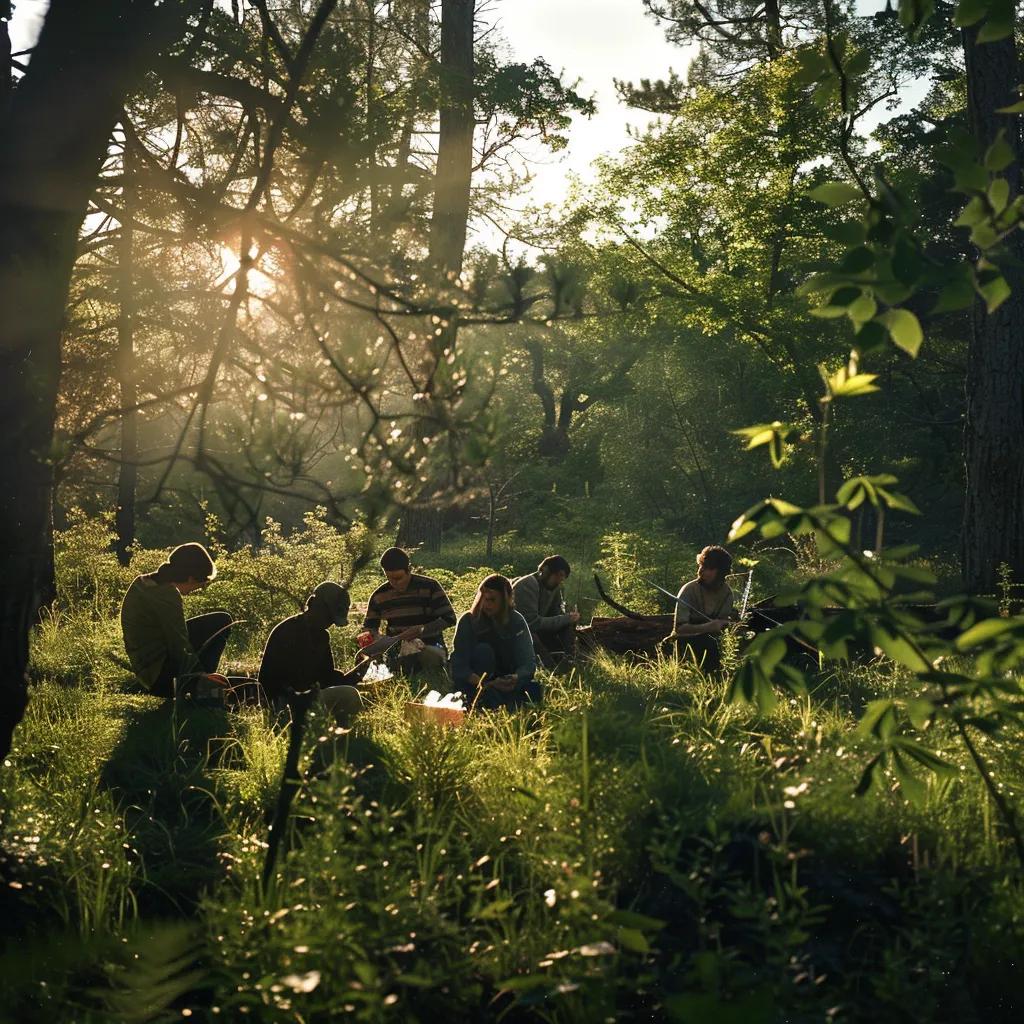Eco-Friendly Adventure Team-Building for Corporate Retreats


Corporate teams seeking to strengthen bonds while reducing their environmental footprint can unlock lasting engagement through eco-friendly adventure activities that blend environmental stewardship with immersive challenges. This guide outlines how sustainable team building fosters corporate social responsibility, highlights nature-based retreats, and demonstrates planning strategies that ensure both employee well-being and a measurable CSR impact. You will discover:
- Core concepts and benefits of eco-friendly adventure activities
- Top sustainable team building formats that drive cohesion
- Ideal eco-conscious venues and selection criteria
- Tangible benefits for communication, collaboration, and stress reduction
- Step-by-step retreat customization with onedteambuilding.com
- Answers to common implementation questions
- Event planning best practices to maximize sustainability
By integrating these elements, companies can create an unforgettable retreat that aligns with corporate values, engages employees, and showcases a genuine commitment to sustainability.
Eco-Friendly Adventure Activities for Sustainable Corporate Retreats
Eco-friendly adventure activities are structured outdoor or conservation-oriented experiences designed to promote environmental stewardship while enhancing team performance. These activities integrate principles of sustainability—such as minimal waste and habitat restoration—with targeted challenges that develop leadership, communication, and collaboration. For corporations, selecting these activities demonstrates CSR commitment, fosters employee morale, and preserves natural settings for future retreats.
Benefits of Eco-Friendly Activities
Eco-friendly adventure activities are designed to promote environmental stewardship while enhancing team performance. These activities integrate sustainability principles, such as minimal waste and habitat restoration, with challenges that develop leadership, communication, and collaboration skills.
United Nations Environment Programme (UNEP), “Ecotourism and Sustainability” (2018)
This research supports the article’s claims about the core concepts and benefits of eco-friendly activities.
How Do Eco-Friendly Activities Promote Sustainability and CSR in Corporate Events?
Eco-friendly activities support sustainability by embedding conservation practices—like waste reduction, renewable resource use, and ecological education—into team challenges. Participants engage directly in environmental restoration, which aligns company values with community impact. This hands-on approach to CSR elevates brand reputation and fosters authentic employee pride in shared environmental achievements.
What Types of Adventure Activities Are Considered Eco-Friendly?

Adventure activities that minimize ecological impact and promote conservation include guided wilderness survival, habitat restoration projects, and low-impact nature treks. Each format emphasizes leave-no-trace principles, renewable energy support, or local resource engagement, ensuring retreats leave positive environmental legacies rather than footprints.
Why Are Nature-Based Activities Effective for Team Building and Employee Well-Being?
Nature-based activities immerse teams in restorative environments where shared challenges naturally encourage trust, problem-solving, and open communication. The combination of fresh air, physical engagement, and purposeful tasks reduces stress hormones and promotes mindfulness, leading to improved morale and sustained productivity back in the office.
Impact of Nature-Based Activities
Nature-based activities immerse teams in restorative environments, encouraging trust, problem-solving, and open communication. The combination of fresh air, physical engagement, and purposeful tasks reduces stress hormones and promotes mindfulness, leading to improved morale and sustained productivity.
American Psychological Association, “The Benefits of Green Exercise” (2019)
This citation supports the article’s discussion on the benefits of nature-based activities for team building and employee well-being.
Which Sustainable Team Building Activities Enhance Corporate Team Cohesion?

Sustainable team building activities that consistently drive cohesion include immersive nature challenges, eco-volunteering initiatives, and creative green workshops. Each format offers distinct mechanisms—problem-solving under natural constraints, collective contribution to conservation, and collaborative innovation—that reinforce trust, accountability, and shared achievement.
Below is a comparative table of core activity categories, their attributes, and team benefits:
| Activity Category | Core Attribute | Team Benefit |
|---|---|---|
| Nature-Based Challenges | Wilderness survival scenarios | Enhances leadership and resilience |
| Eco-Volunteering | Community conservation projects | Boosts morale through shared purpose |
| Green Workshops | Hands-on sustainable creation | Inspires creativity and eco-awareness |
These sustainable activities complement one another to form a cohesive retreat agenda that balances challenge, service, and innovation, setting the stage for venue selection and detailed planning.
What Are Nature-Based Team Challenges and Their Leadership Benefits?
Nature-based challenges such as wilderness survival, orienteering, and eco-scavenger hunts require teams to navigate real-world scenarios with limited resources. By problem solving under natural constraints, participants develop strategic thinking, decisive leadership, and heightened situational awareness—skills directly transferable to corporate decision-making environments.
How Do Eco-Volunteering Programs Support Environmental Conservation and Team Morale?
Eco-volunteering programs—like mangrove restoration, trail maintenance, and beach cleanups—engage teams in tangible conservation work. Contributing to environmental health fosters collective pride and a sense of accomplishment. Witnessing immediate ecological improvement reinforces team cohesion and aligns corporate CSR goals with measurable community impact.
What Green Workshops Inspire Creativity and Sustainability Awareness?
Green workshops such as terrarium building, upcycled art projects, and sustainable cooking challenges merge hands-on crafting with eco-education. These collaborative sessions encourage innovation, diversify skill sets, and deepen environmental understanding—all while producing sustainable artifacts or meals that symbolize each team’s creative and ecological achievement.
Where Can You Find Unforgettable Eco-Friendly Retreat Locations for Corporate Teams?
Choosing the right retreat location involves evaluating venue sustainability credentials, the immersive quality of natural settings, and logistical considerations for group comfort and safety. Ideal venues range from LEED-certified resorts powered by renewable energy to remote nature reserves that facilitate digital detox and deeper nature connection.
What Are the Features of Eco-Conscious Venues for Corporate Retreats?
Eco-conscious venues typically hold certifications such as LEED or Green Globe, employ solar or wind energy, implement water-conservation systems, and source local organic catering. These features reduce carbon footprint and reinforce the retreat’s sustainability narrative, deepening employee engagement with CSR values.
How Do Outdoor Retreat Settings Enhance the Eco-Friendly Experience?
Outdoor settings—national parks, wildlife sanctuaries, and coastal reserves—provide authentic immersion in biodiversity and tranquility. Such environments catalyze team bonding through shared exploration and highlight the importance of conservation by showcasing ecosystems in need of stewardship.
How to Choose the Best Location for a Sustainable Corporate Retreat?
Selecting a location requires balancing accessibility, accommodation capacity, environmental credentials, and activity compatibility. Companies should assess transportation emissions, on-site amenities for varying fitness levels, and proximity to conservation areas. Partnering with a specialist like onedteambuilding.com ensures tailored site selection with turnkey logistics and sustainability alignment.
What Are the Key Benefits of Eco-Friendly Team Building for Companies and Employees?
Eco-friendly team building yields measurable improvements in communication, corporate reputation, and employee well-being by integrating purposeful environmental action with experiential learning. These retreats strengthen internal culture while demonstrating external CSR leadership.
How Does Eco-Friendly Team Building Improve Communication and Collaboration?
Structured challenges in natural settings disrupt hierarchical norms, encouraging equal participation and active listening. Teams learn to share information clearly, solicit diverse perspectives, and build on collective strengths—resulting in smoother collaboration on subsequent corporate projects.
In What Ways Does Sustainable Team Building Align with Corporate Social Responsibility?
By embedding conservation and community projects within team experiences, organizations tangibly invest in environmental stewardship and societal benefit. This alignment elevates CSR reporting, attracts purpose-driven talent, and enhances stakeholder trust through demonstrable actions rather than rhetoric.
How Does Nature-Based Retreats Support Employee Well-Being and Stress Reduction?
Spending time in green environments lowers cortisol levels, improves mood, and enhances focus through biophilic engagement. Structured mindfulness exercises, nature walks, and reflective debriefs foster mental resilience, making employees more engaged and productive upon return.
How Can You Plan and Customize an Unforgettable Eco-Friendly Corporate Retreat?
Crafting a seamless sustainable retreat involves defining objectives, selecting activities and venues, and coordinating logistics with expertise. A clear roadmap ensures alignment with corporate goals, participant needs, and environmental standards.
What Steps Are Involved in Organizing a Sustainable Team Building Retreat?
- Define retreat goals, budget, and desired CSR outcomes.
- Choose eco-friendly activities aligned with skill development and conservation impact.
- Select a certified sustainable venue with appropriate facilities.
- Arrange logistics—transport, catering, and equipment—using local, low-carbon options.
- Facilitate post-retreat evaluation to measure team performance and environmental impact.
These steps guide corporations through a structured process, guaranteeing both impact and feasibility for large or small groups.
How Does onedteambuilding.com Tailor Eco-Friendly Adventure Activities to Corporate Needs?
onedteambuilding.com specializes in custom programs that integrate leadership development with environmental initiatives. Through pre-retreat consultations, they match activity intensity to team dynamics, curate venue partnerships with green credentials, and handle all logistical arrangements to deliver a holistic, drag-and-drop retreat experience.
What Are Examples of Successful Eco-Friendly Retreats and Their Outcomes?
Recent corporate clients have reported a 25% increase in cross-departmental collaboration scores and a 40% improvement in CSR perception after participating in multi-day retreats featuring tree planting, wilderness navigation challenges, and sustainable cooking workshops. These outcomes highlight the powerful synergy between environmental action and team empowerment.
What Are Common Questions About Eco-Friendly Retreat Activities?
Teams often wonder how to implement sustainable ideas, measure their impact, and leverage retreats to attract talent. Addressing these concerns with clear guidance ensures confident planning and impactful results.
What Are Some Easy-to-Implement Eco-Friendly Team Building Ideas?
Easy-to-implement activities include nature photo scavenger hunts that require minimal equipment, zero-waste picnic challenges sourcing local produce, and indoor upcycling contests using office recyclables. These initiatives deliver immediate engagement and sustainability awareness without complex logistics.
These simple options allow companies to pilot sustainability concepts before scaling to multi-day outdoor retreats.
How Can Companies Measure the Impact of Sustainable Team Building?
Impact measurement can use carbon footprint calculators for travel and venue, pre- and post-retreat surveys on team cohesion, and CSR scorecard metrics such as trees planted or waste diverted. Combining quantitative data with qualitative feedback provides a holistic view of environmental and team benefits.
How Do Eco-Friendly Retreats Attract and Retain Top Talent?
Purpose-driven retreats signal genuine corporate investment in employee values and community impact. Demonstrating a commitment to sustainability and well-being elevates employer branding, leading to higher application rates, lower turnover, and stronger employee advocacy.
How Does Sustainable Event Planning Enhance the Overall Corporate Retreat Experience?
Sustainable event planning weaves environmental considerations into every aspect of a retreat—from vendor selection to waste management—ensuring the entire experience reinforces CSR values and heightens participant engagement.
What Are Best Practices for Reducing Environmental Impact at Corporate Events?
Best practices include sourcing renewable-energy venues, implementing comprehensive recycling stations, offering plant-based menus, and opting for digital materials over single-use print. These measures minimize waste and carbon emissions while modeling responsible practices for attendees.
How Do Eco-Friendly Venues Support Corporate Sustainability Goals?
Eco-friendly venues provide transparent reporting on resource consumption, use green building materials, and maintain conservation programs on-site. Partnering with such venues amplifies a company’s sustainability narrative and simplifies CSR documentation.
What Trends Are Emerging in Sustainable Corporate Retreats?
Emerging trends include carbon-neutral travel packages, regenerative tourism that gives back to local communities, hybrid virtual-in-person eco-events, and integration of wellness technologies like circadian lighting. Staying ahead of these trends positions corporations as sustainability innovators.
Corporate teams that adopt these advanced practices not only deliver memorable retreats but also reinforce their leadership in corporate responsibility and employee development.


